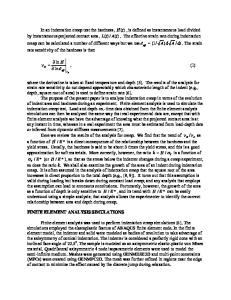Retardation of cyclic indentation creep exhibited in metal alloys
- PDF / 945,522 Bytes
- 7 Pages / 612 x 792 pts (letter) Page_size
- 20 Downloads / 358 Views
Yun Che Wang Center for Micro/Nano Science and Technology and Department of Civil Engineering, National Cheng Kung University, Tainan, Taiwan 701
Jen Fin Lina) Center for Micro/Nano Science and Technology and Institute of Nanotechnology and Microsystems Engineering, National Cheng Kung University, Tainan, Taiwan 701 (Received 11 March 2008; accepted 13 June 2008)
Depth penetration per cycle and its retardation exhibited in specimens of 6061 Al were studied. By holding the maximum load reached during loading prior to cyclic oscillating, the creep could be effectively attenuated from the cyclic indentation. Constant depth penetration of sub-nanometers per cycle was found. The interrupt segments with different amplitudes (over- and underloading) or frequencies (frequency increasing and decreasing), but with same mean load, induced immediate retardations of cyclic indentation. As the interrupt segments have more than 10 cycles, the retardation is enhanced with the increase of cycle number. Accumulation of strain hardening due to stress concentration under the indenter tip is proposed to be the mechanism by which interrupt oscillation retards subsequent cyclic indentation.
I. INTRODUCTION
Cyclic stress may induce creep in metals and alloys during uniaxial testing.1 A significant creep rate could be found even at room temperature due to cyclic softening. Bennett and Evans2 found that there are two stages: the first stage is rapid recovery during unloading, which is produced by the cross-slip of screw dislocations, and the second stage involves an increase in edge dislocations. They also proposed a simple model involving the three factors—flow stress, applied stress, and the stress removed during unloading—to discuss their experimental results. Significant creep was also found in dynamic indentation experiments; that is, an indenter continuously “sank” into the materials with oscillating load, even when the indenter was flat-ended. Under cyclic loading, the plastic zone under the indenter propagates into the material during every cycle. The plastic zone propagation per cycle is related to the oscillating conditions, i.e., the mean load, the amplitude, and the frequency. On the basis of the simulation for elastic–perfectly plastic materials, Yang and Saran3 found that the plastic zone propagation per cycle increases with increases in the mean value and amplitude of the oscillating load. Using a kinetic hardening model, Xu and Yue4 simulated the a)
Address all correspondence to this author. e-mail: [email protected] DOI: 10.1557/JMR.2008.0323 2650
http://journals.cambridge.org
J. Mater. Res., Vol. 23, No. 10, Oct 2008 Downloaded: 31 Mar 2015
steady-state depth penetration per cycle in annealed copper indented by a punch. From experimental investigations in the literature, cyclic loading conditions were reported5–9 to allow the indenter to penetrate continuously into materials. The effect of oscillation frequency used for the cyclic loading process was found to be an important factor in cyclic indentation. By ex
Data Loading...











